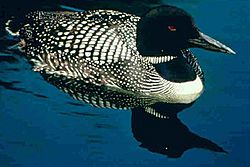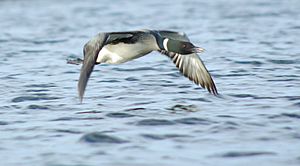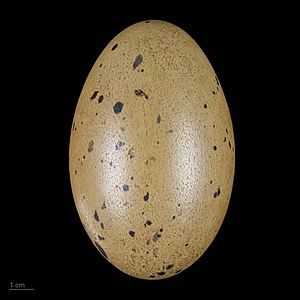Great Northern Diver facts for kids
Quick facts for kids Great Northern Diver |
|
|---|---|
 |
|
| Conservation status | |
| Scientific classification | |
| Kingdom: | |
| Phylum: | |
| Class: | |
| Order: | |
| Family: | |
| Genus: |
Gavia
|
| Species: |
G. immer
|
| Binomial name | |
| Gavia immer (Brunnich, 1764)
|
|
The Great Northern Diver, also known as the Common Loon, is a large bird. It belongs to the diver family. Adult loons are quite big, usually 70 to 90 centimeters (about 2.3 to 3 feet) long. Their wings can spread out from 1.2 to 1.5 meters (about 4 to 5 feet) wide!
These birds spend their summers and raise their young in places like North America, Greenland, Iceland, and Scotland. When winter comes, they fly to warmer areas. They can be found on sea coasts or big lakes in southern Europe, the United States, and even parts of northwestern Africa.
What Great Northern Divers Eat
Like all divers, the Great Northern Diver is a special fish-eater. It catches its food underwater. These birds can dive very deep, sometimes as far as 60 meters (about 200 feet)!
Their diet changes depending on where they are:
- In freshwater, they eat fish like pike, perch, sunfish, trout, and bass.
- In saltwater, they enjoy fish such as rock fish, flounder, sea trout, and herring.
Reproduction and Life Cycle
Female Great Northern Divers usually lay 1 to 3 eggs. They make a simple nest, which is a hollowed-out mound of dirt and plants, very close to the water.
Both parents work together to build the nest. They take turns sitting on the eggs to keep them warm until they hatch. Once the young birds are born, both parents also help feed them.
Images for kids
-
Juvenile swimming in the ocean off Mcgee Island, Maine
-
On a nest by water in Maine, U.S.
See also
 In Spanish: Colimbo grande para niños
In Spanish: Colimbo grande para niños











